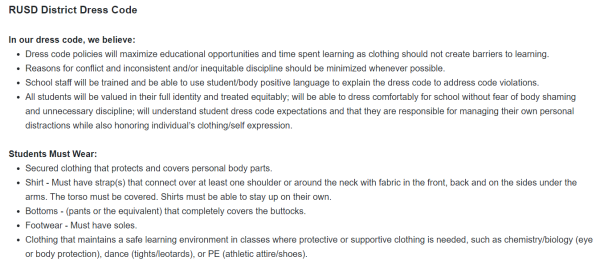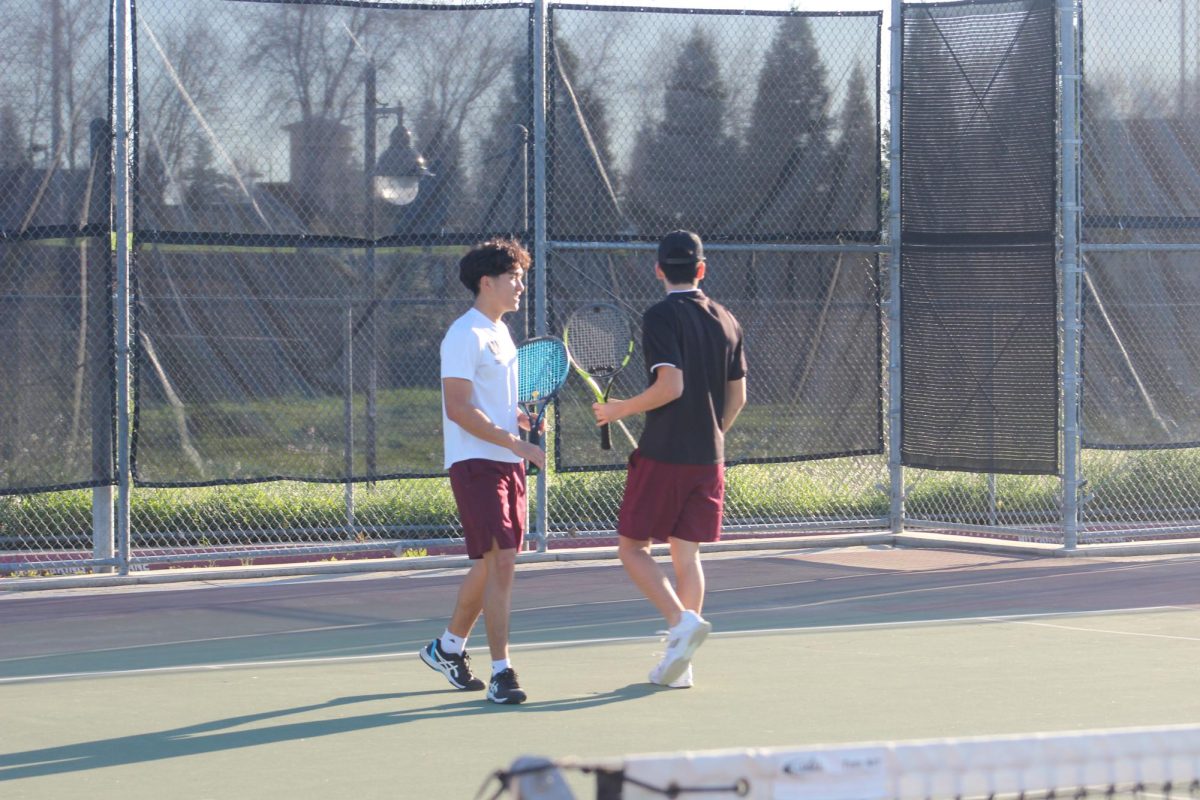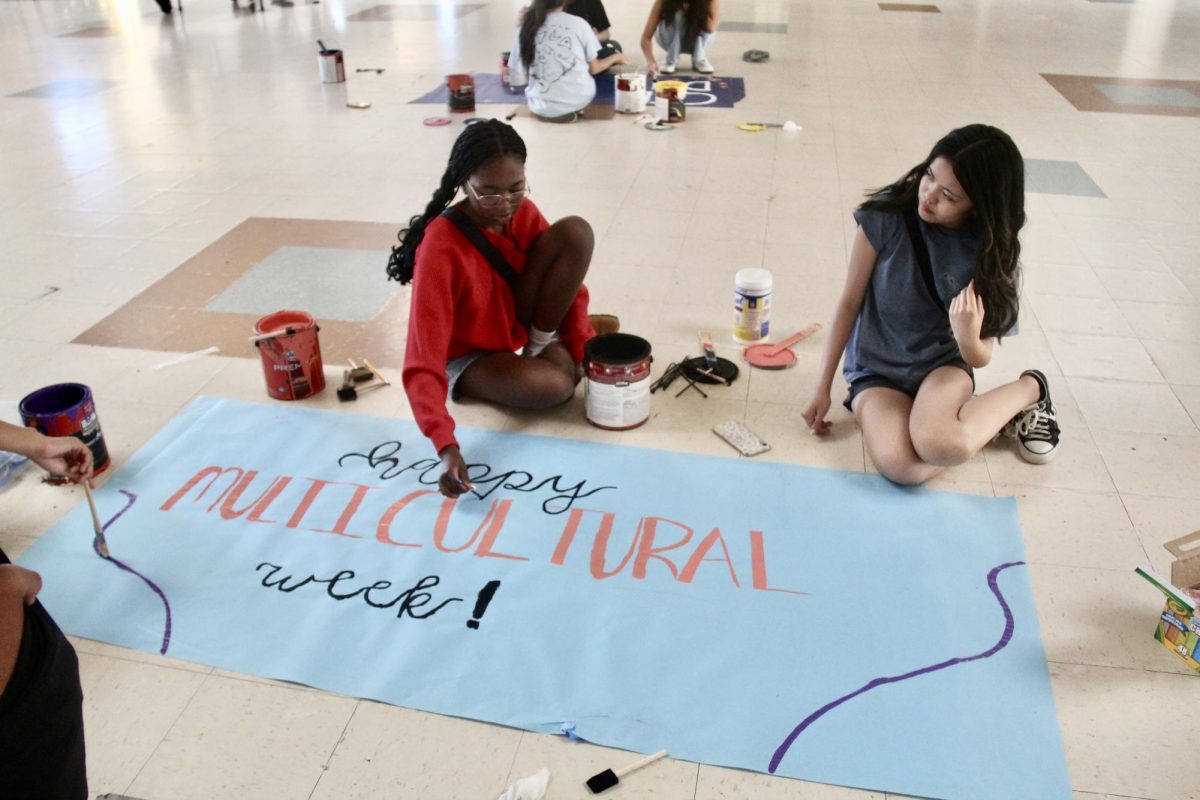As the white-flowering trees start to cover the campus with its blossoms, the sun beats directly into the air and lingers in the sky for a little longer, students shed their hoodies, sweatpants and long-sleeved shirts in favor of lighter layers and creative freedom – until they are met with a dress code violation.
Recently, some students have been affected by the RUSD Dress Code as the warmer weather rolls in. This semester alone, 10% of students have been dress coded, according to an Instagram poll April 14-15, which had 222 responses.
According to the dress code, students must have straps connected to their shirts, pants or the equivalent that completely cover their behinds and tops that touch the bottom of their torsos – all while wearing clothing that maintains a safe learning environment that maximizes educational opportunities and time spent learning. This means no short shirts, no strapless shirts, no cleavage and no short shorts.
“This is a policy that I follow, alongside all of the other assistant principals and admin,” Assistant Principal Ms. Penelope Shelton said. “This is actually a semi-professional environment in an academic setting where we’re actually helping students learn what’s appropriate for the workplace; there’s not many workplaces where a half shirt would ever be appropriate.”
As the standard around the professional industry remains, students question how much of a role they have, as students in a public school, in the academic workplace.
“In middle school, I’ve had some of my teachers be like, ‘Oh, well, you’re in a professional environment,’” Sophia Banchio said. “And to them it’s professional, which makes sense because they’re actually employed here, but to us it’s really not. We’re here to get our public education.”
Students have opinions on the policy, and it’s common to hear grumblings of it being unfair and inconsistent, with guidelines that are enforced with outdated gender norms and disproportionate focus on girls. According to the code, one of the only realistic ways for a boy to get dress-coded is for them to walk into school without a shirt or shoes on. For young women, the idea of “covering up” often pushes inherent sexist stereotypes and could make them feel self-conscious or ashamed of their fashion choices. When students are called out by their teachers or by being given oversized and used T-shirts to wear, the idea purges itself even more.
“I have been dress-coded and I think we shouldn’t be sexualizing girls at school because we’re in what’s supposed to be a ‘safe environment,’ Banchio said. “If we’re having to put less revealing clothes on girls, obviously it’s not safe because we’re worried about what could happen.”
In a generation heavily focused on meeting and conforming to society’s standards, girls everywhere are influenced by what they see and hear. Correspondingly, their choice for what they put on each day will often reflect that – and realistically, it’s because students don’t want to wear out of date clothing – they want to wear what is in trend.
“I was dress-coded at break and I was super embarrassed because apparently my stomach was showing too much,” Amelia Williams said. “I really just want to wear what I want to wear. It was annoying, like, why are [administrators and staff] looking at me in that sort of way. To me, it’s like adults sexualizing kids, and I feel like people with more ‘adult bodies’ are more likely to get dress coded, which is so weird.”
The question remains: why are staff and administration still conforming and enforcing outdated and sexist guidelines if it’s not affecting students around those affected by the dress code? The answer is due to the fact that the school is a semi-professional environment where the goal is to not “distract” those from their education.
“It’s like any job – it’s a professional atmosphere and you should dress fairly conservatively,” Assistant Principal Mrs. Lisa Gack said. “Since becoming an assistant principal [within the last year], I see the tank tops, sleeveless shirts, shorts, skirts and things like that more than I usually did inside the classroom since most wore jackets and sweatshirts. We, for modesty, need to follow dress code. I think it’s important that we take into consideration everybody around us and create an atmosphere that we’re happy with.”
The stereotype around the dress code is that male students are distracted by visible shoulders, midriffs or tighter and shorter clothing. However, that might not actually be the case in the 21st century as it may have been in the 20th century.
“I am not distracted in the slightest by what girls wear to school,” Michael Payan said. “Everyone has shoulders and everyone has stomachs. The dress code is programmed against women and they should be able to wear what they want because, [and this is] coming from a man, it has no effect on us.”
The debate between self expression and conformity may continue its saga as more girls around campus will continue to be in states of constant wardrobe worry.
“When I got dress-coded, I felt singled out [because] no one else around me got dress-coded,” Jenna Corpuz said. “It made me feel embarrassed by the end of the day. All I was trying to do was enjoy lunch, and for some reason I wasn’t [able to] in peace.”
by ALYSSA FOLMER












